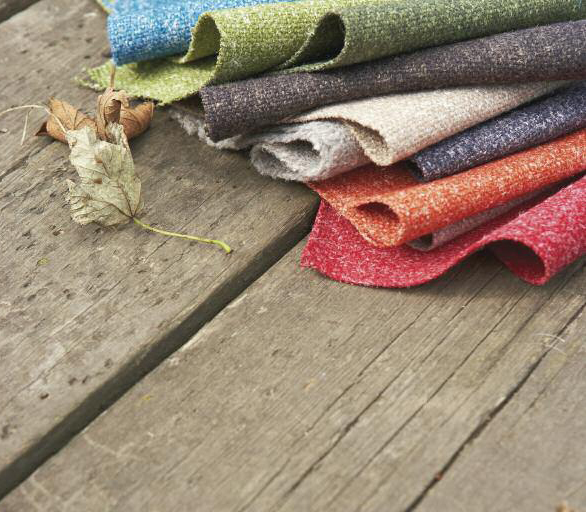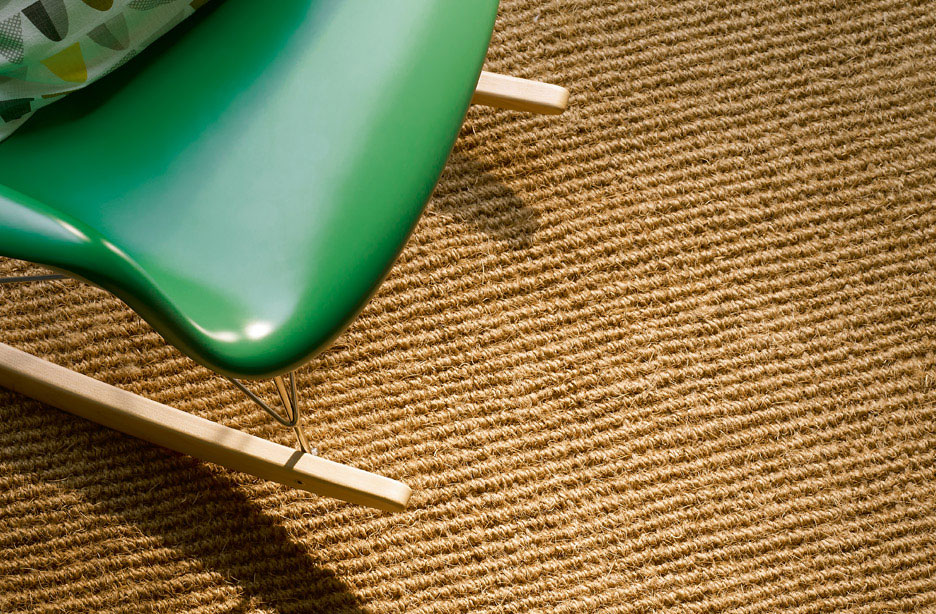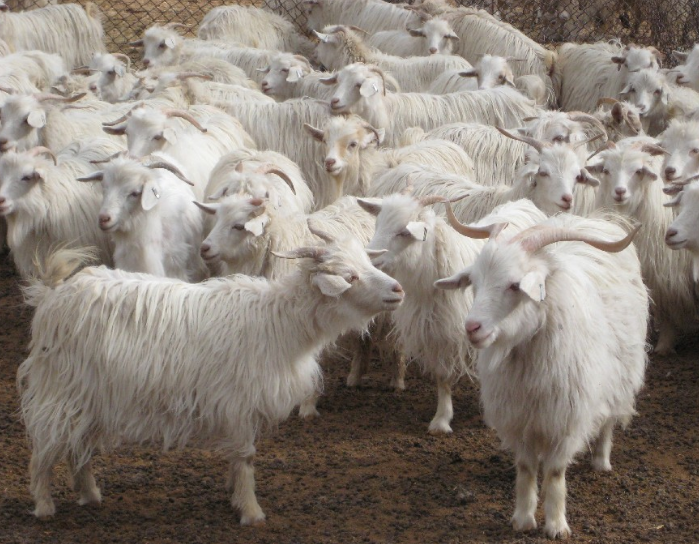Deco's A to Z of natural fibres
Ok, what's hemp? what's vicuña? ...not sure?..well you need Kay Hill's guide to fibres and fabrics to help you make the most environmentally-friendly choices when buying floor coverings and textiles

R is for rushes... rush matting can suit contemporary interiors as well as more humble cottages the floor covering is perhaps associated with. Bedfordshire-based Rush Matters offers this lovely hand-made, UK-sourced flooring from £260 m2. A topline summary - the most eco fibres include hemp, flax (organic linen), nettle, ramie, Peace silk, bulrushes, rattan, organic wool and Tencel.
ALPACA. It's wool taken from the South American llama-like alpaca. It is soft and warm, naturally water-repellent and fire-resistant and has no lanolin, making it suitable for those with allergies to sheep’s wool. There are two breeds, Suri and Huacaya which have slightly different wool.
Environmental impact: Most alpaca wool comes from small scale producers in Peru, the US, Australia and the UK. Alpacas are low-maintenance animals that don’t destroy pastures and aren’t bred in areas where rainforests might be cleared for them. The wool requires some water usage during the washing process and dyes used on it may vary in their impact depending on whether vegetable or chemical dyes are used. Alpacas are not harmed during wool shearing, although in Peru they are eaten for meat and the hides then used for rugs and throws.
ANGORA is the downy coat from the Angora rabbit. Fibres have a hollow core making them very warm, light and fluffy. As it isn’t a particularly strong fibre it is often mixed with wool to make it more durable. Not to be confused with mohair which is the fibre from the Angora goat.
Environmental impact: Angora is generally farmed on a small scale so has little environmental impact, although some water is used during the washing process. Angora can be harvested in a painless way by collecting moulted hair or by shearing the rabbits, but the best fibres are obtained by plucking live rabbits around three times a year, a process that causes some discomfort and distress. Peta, the animal rights organisation, says this about angora: Angora rabbits are strapped to a board for shearing, kicking powerfully in protest. The clippers inevitably bite into their flesh, with bloody results. Angoras have very delicate foot pads, making life on a wire cage floor excruciating and ulcerated feet a common condition. Because male Angora rabbits have only 75 to 80 percent of the fur yield of females, they are killed at birth on many farms.
BAMBOO. A fibre made from the crushed leaves of bamboo plants and one that's becoming increasingly widely used. It has a natural sheen and softness and antibacterial properties that make it popular for towels and nappies.
Environmental impact: The crop can be cut annually and then regrows, and its production doesn’t usually require irrigation, herbicides or pesticides. However, to make bamboo fabric, the woody stems have to be broken down. This can be done in an environmentally friendly way by mechanically crushing the plants, using natural enzymes to turn them into mush, then combing out the fibres and spinning them into yarn. But around 90 per cent of the time a chemical process is used, involving caustic soda, carbon disulphide and sulphuric acid. These chemicals are potentially dangerous to people and the environment if they escape.
CAMEL HAIR. It comes, unsurprisingly, from camels, which naturally shed more than 2kg of hair a year. It can either be collected after the animal has shed it, combed or sometimes shorn from the beast. Most camel hair comes from Mongolia, Kazakhstan and China. Woven, the fabric is very warm and the fibres are good for filling duvets.
Environmental impact: Some water is used during the cleaning, but the fabric is seldom dyed so few chemicals are used. Camels are not harmed during the wool collection.
CASHMERE comes from the soft underbelly of the cashmere goat, which lives in the high plateaus of Asia and in north west China. Textiles made from cashmere are warm, soft and can be very hardwearing - which may surprise those who curse the moths that so quickly munch their way through cardigans and jumpers...
Environmental impact: The wool is combed or shorn from the goat so it's not harmed during the process. The big issue with cashmere, however, is deforestation. As demand for cashmere fibres has grown, so the number of goats has increased, and with each goat eating 10 per cent of its body weight in vegetation every day, overstocking has led to desertification, dust storms and air pollution in some parts of China - as well as starvation for many goats.
COIR. Derived from long fibres from the husks of coconuts. And not surprisingly, it's hard-wearing and often used for flooring. Coir flooring is available at Crucial Trading.
Environmental impact: Coconuts are a good food source and the coir was originally just a waste product. Water is used in the production of fibres as the coir is soaked in lagoons for up to six months. Attempts to hasten the process using chemicals such as bleach can cause pollution.
COTTON. The most widely used fabric, cotton is made from the soft, silky fibres from the bolls which grow around the seeds of the Gossypium cotton plant. It produces a fabric which is breathable, soft and easy to launder – around half of the fabrics in the world are made from or contain some cotton.
Environmental impact: Cotton is a dirty crop and we can all do our bit to help by switching to ORGANIC COTTON. Although it covers just 2.5 per cent of the world's cultivated land, cotton production uses 16-25 per cent of the world's insecticides, and up to five million cases of pesticide poisoning occur every year, resulting in up to 20,000 reported deaths among agricultural workers (source: Soil Assocation). Child labour is still used in many cotton growing areas, including Pakistan, Turkmenistan, India, Egypt and Uzbekistan. Nearly a third of cotton is grown from genetically-modified seeds which do not produce significantly higher yields, but costs farmers twice as much to produce and means they cannot collect their own seeds from which to grow next year’s crop. Organic cotton avoids most of these issues - although it is still a thirsty crop requiring a large amount of water.
FLAX is one of the oldest fibre crops in the world, obtained from the flax plant Linum usitatissimum, which also gives us linseeds. Cloth made from flax is known as linen. Flax grows wild and does not require anywhere near as much water to grow as cotton does, nor does it need much in the way of pesticides. Very little energy is used to process the flax.
Environmental impact: Flax stems undergoing “retting” when they are left in water for days or weeks for the soft flesh to rot. If done in tanks this creates polluted, acidic water, although it is often done in moving water with little ill effects - the highest quality linen in the world is retted in Belgium in the River Lys. Chemical retting is faster but uses environmentally hazardous chemicals and produces a poorer quality fabric.
HEMP fibres are longer, stronger, more durable and more absorbent than cotton. Hemp production is restricted as it is the same plant from which marijuana comes, although commercially grown hemp has very low quantities of the drug. Interior designer Emily Todhunter offers organic hemp fabric in a lovely palette of colours, made using hemp grown in Romania, and she likewise has fabulous organic linens.
Environmental impact: Hemp is a fast growing and renewable crop that can be harvested every three to four months, and is very effective in absorbing carbon dioxide, one of the principal greenhouse gases. It grows well without the need for irrigation or pesticides, but does require fertilising or regular crop rotation. HORSEHAIR. The longest natural fibre available, horsehair's combination of toughness and springiness makes it popular in bed-making and upholstery and for hard-wearing fabrics. John Boyd Textiles make some of the finest horsehair fabrics.
Environmental impact: It is a by-product of the meat industry which would otherwise go to waste.
JUTE is an Indian plant that produces long, soft, shiny fibres that can be spun into coarse, strong threads, popular for rugs and carpeting.
Environmental impact: Jute is a rain-fed crop with little need for fertilizer or pesticides. The fibres have to be retted in running water, in the same way as flax, but this generally doesn’t cause pollution. Jute fibres can be recycled into new jute products and biodegrade at the end of use.
KAPOK is a soft, breathable, buoyant and mould-resistant fibre found in the seed pod of the rainforest kapok tree in South America. It can be made into fabric but is most often used as a stuffing material, although it is quite flammable.
Environmental impact: It is gathered rather than farmed, and since it lives in rainforest environments it offers a sustainable crop that could help to protect these areas from clearing to grow other cash crops.
KENAF is an ancient African hibiscus plant, related to both cotton and okra, now being grown as a crop in the US, where it's used mainly for paper-making, although it can also make a coarse cloth fabric.
Environmental impact: The whole of the plant is harvested and used to produce fibres, so nothing is wasted. Kenaf is a hardy plant that requires a minimum of fertilizers, pesticides and water.
KESAV is a perennial herb grown in Northern India. The sword-shaped leaves take up to two years to grow large enough and are harvested at the end of the monsoon, when they're soft from the rain. It's mainly used in rope-making and basket weaving, but is now also being used for flooring and rugs such as the new Ella Doran collection for Wovenground
Environmental impact: It is a labour-intensive hand-crafted fibre, made on a small scale in rural areas.
LINEN - see Flax
MILK FIBRE was first used to make fabric during the First World War by the Germans when cotton was in short supply. Liquid milk is dried and its proteins extracted, these are dissolved in a chemical solution then spun into fibres. It produces a breathable, absorbent, soft yet rather delicate fabric.
Environmental impact: The production of milk is quite energy intensive as cows eat large quantities of feed, and also produce the greenhouse gas methane. Vegans don’t agree with dairy production as it involves the slaughter of unwanted male calves. However, milk fabric is normally made from milk not suitable for human consumption. Manufacturing processes vary, some use alkalis and acids plus acrylonitrile, a chemical both polluting and carcinogen if it escapes. Others, like German company QMilch claim a completely natural, eco-friendly process.
MODAL is a fabric made from cellulose taken from beech trees. Popular for towels and bedding because it absorbs water twice as well as cotton and mineral deposits from hard water don’t stick to it.
Environmental impact: Beech trees are from renewable plantations that require few agro-chemicals and an environmentally-friendly method is used for bleaching. However the manufacturing process involves the use of toxic chemicals, heavy metals and a fair amount of water so some argue while it's natural, it's not eco..
MOHAIR is a soft durable fabric or yarn made from the hair of the Angora goat. It is insulating, moisture-wicking and fire-resistant. Each goat produces up to eight kg a year, with the biggest producers being South Africa and Texas. Spanish company Mantas Ezcaray manufactures top quality mohair fabric for cushion covers, throws and other home accessories. You can buy its products in the UK at Heal's.
Environmental impact: Goats are not harmed during the twice-yearly shearing and live a fairly free-range existence on natural pasture, requiring very little artificial input. Water is used in the washing process, and energy to dry the yarn. Chemical dyes may be used.
NETTLE fibre was made as long ago as the Second World War by the Germans to provide uniforms for troops, but fell out of favour as cotton was a cheaper alternative. It has now been revived by Camira Fabrics for its Sting upholstery fabric, which mixes nettles with wool. You can buy nettle 'wool' from Nepal to knit with from the Transrural Trust, a charity that works with women in disadvantaged rural areas in Nepal and other countries.
Environmental impact: Nettles grow rapidly from springtime, reaching up to 2.5 metres. They grow easily, without pesticides or herbicides, on land which is often unsuitable for other crops, such as floodplains or brownfield sites, and they provide a natural habitat for wildlife. They’re harvested in late summer and left to dry out on the field while their leaves naturally decompose and provide nutrients for the following year’s crop. The nettle stems are mechanically crushed and the fibres separated before being woven (sometimes with wool) on looms.
OKRA is generally grown for food, but its stems also have strong fibrous strands that can be plaited into ropes and used for flooring.
Environmental impact: Interiors products are a useful way of using the whole plant. Okra is frequently treated with pesticides.
PAPER FIBRES are made from wood, and usually have a resin added during production to make them more durable.
Environmental impact: Paper is more often than not these days produced from sustainable, farmed trees.
PASHMINA is made from the fleece of the pashmina goat that lives in the Himalayas. It is a luxurious soft, insulating fabric.
Environmental impact: The popularity of pashmina shawls among fashion-conscious women has done much to improve the living conditions of the previously very poor, mainly nomadic herders. But it could be a victim of its own success as overpopulation of goats is threatening indigenous wildlife in some areas. The wool needs to be washed but otherwise is turned into yarn locally in a simple mechanical process.
PITA is a natural fibre obtained from a Mexican Agave plant (Agave americana) and woven into a tough fabric.
Environmental impact: Usually a small-scale, mechanical production carried out in rural areas.
RAFFIA comes from a specific type of Raphia palm tree that originated in Madagascar but is now farmed in East Africa. The leaves are stripped and dried to make strands that can be woven or plaited. Fibres are soft, durable and easy to dry.
Environmental impact: The trees don’t usually require agro-chemicals and production is labour intensive, mechanical and local.
RAMIE comes from the Boehmeria nivea, a flowering plant in the nettle family, native to eastern Asia. It is one of the oldest fibre crops, having been used for at least six thousand years to make fabric.
Environmental impact: The crop is a rapidly renewable source and requires almost no agro-chemicals. If the plants are left for natural dew retting in the field it produces little pollution, water-retting in tanks does produce a large amount of polluted water, while chemically speeded-up retting involves toxic chemicals.
RATTAN is a quick-growing type of grass with long stems that can be used to weave furniture and flooring. Indonesia is the largest producer.
Environmental impact: Rattan grows quickly and seldom requires chemicals, and it will grow on poor soil that wouldn’t support food crops. It also thrives on land between fruit or rubber trees, providing an extra source of income. The processing is a simple, mechanical process that is labour-intensive but non-polluting.
RATI comes from the Sugar Palm plant which has leaves up to four metres long. Commonly used for thatching, making mats and baskets it also yields a soft fibre that can be used for flooring and other items.
Environmental impact: Grown on a small scale mainly in Asia, with the palms also used to produce sugar.
RAYON also called Viscose is also known as art silk because of its softness and lustre, and it is a breathable and absorbent fabric. It was the first artificially regenerated fibre from cellulose, dating back to 1855. The cellulose comes from sustainable plantations of beech trees.
Environmental impact: There are many different processes for manufacturing rayon, but plenty of water, plus potentially toxic and polluting chemicals such as caustic soda are involved in turning the cellulose into a soluble compound, which is then spun to form soft filaments.
RUSHES grow in the UK. Felicity Irons of Rush Matters harvest wild bulrushes, with stems up to 3m long. The fibres can be woven into rugs, baskets, tableware and flooring.
Environmental impact: Rrushes are wild with no chemicals used on them. They are harvested by hand then dried and bleached in the sun, in a zero-carbon, completely natural process.
SILK is a soft, lustrous and luxurious fabric made from threads taken from the cocoon of the silk moth.
Environmental impact: Silk requires little processing before it's spun, although water and sometimes chemicals may be used during the washing process, and chemical dyes are used. Large scale production involves precisely controlled temperature, lighting and humidity, using large amounts of energy. Vegans are opposed to the use of silk as the moth inside the cocoon is killed during the production process. The exception is Peace silk (also known as wild silk, tussah silk or Ahimsa silk) which is made from discarded cocoons of wild moths.
SISAL comes from the Agave sisalana, a plant which produces a stiff fibre traditionally used in making twine, rope and also flooring. It's produced in Brazil, parts of Africa and China.
Environmental impact: The sisal is mechanically beaten to extract the usable fibres, washed and dried. Artificial drying produces the best quality but uses a lot of energy.
SOY PROTEIN produces a soft, silky fabric that is lustrous, absorbent and quick-drying and has natural anti-bacterial properties.
Environmental impact: Soy protein fabric is made from waste products from the manufacture of soy oil. It is turned into cloth through a cellulose process similar to rayon or bamboo, which usually involves potentially toxic and polluting chemicals such as caustic soda. Most soybeans have also been genetically modified.
TENCEL also called Lyocel is manufactured from the cellulose found in eucalyptus plants. The fabric, mostly used for clothing, is absorbent, breathable and anti-bacterial.
Environmental impact: Eucalyptus grows quickly and without irrigation, pesticides, fertilizers or genetic manipulation, and it thrives on land which would not food crops. Unlike other similar fibres, the process of making Tencel used by its inventors, German company Lenzing, has achieved a European Eco-Label as the water and non-acidic solvents used are kept in a closed loop to avoid any pollution.
VICUNA WOOL comes from the smallest member of the camelid family, the vicuña, possibly an ancestor of the alpaca, which lives at high altitude in the Andes. The wool is so fine that in Inca times only royalty was allowed to wear it.
Environmental impact: Vicuña were hunted almost to extinction in the 1960s for their pelts, although the population has now recovered well. They are now protected from hunting although they can be shorn and released, but they produce enough wool only for this to be done every three years, so vicuna wool is extremely expensive. It is usually left undyed. NB, Peta, the animal rights organisation, says this about vicuña: 'Vicuñas, who are related to camels and llamas and live high in the South American Andes, are exploited for their wool, which is the most expensive material used to make clothing in the world. To obtain their wool, wild vicuñas are typically herded into a V-shaped “funnel trap.” This process is terrifying for these shy animals. Panicked vicuñas have even been known to break their necks during herding by crashing into fences. Their ears are then tagged, without the benefit of painkillers, before the animals are restrained and shorn with electric clippers. The shearers usually only leave the hair on the animals’ bellies and chests, which isn’t enough to protect them from the extreme heat and cold of the Andes.'
VISCOSE see Rayon
WATER HYACINTH is one of the fastest growing plants known, and when not controlled it will completely cover lakes and ponds, impeding water flow and killing other life through lack of sunlight and oxygen. It also creates a prime habitat for mosquitos and snails that cause tropical diseases. Its fibres can be plaited into furniture, flooring and other interiors products.
Environmental impact: Since the plant itself is such a problem, harvesting it and using it usefully is generally considered to be a good thing.
WOOL is one of the best-loved and most sustainable natural fibres, made from the fleece of sheep, and is warm, breathable and naturally fire retardant.
Environmental impact: Most wool comes from large farms in Australia, so it has travelled a long distance to the UK, although we do have an indigenous wool industry. Toxic chemicals may be used in the washing, preparing and dyeing of wool, and during the sheep’s lifespan in the case of sheep dip, although organic wool is also available. Shearing does not harm the sheep and most live in free-range conditions, but some sheep undergo castration, docking of tails and, in parts of Australia, a painful mutilation called mulesing.


























